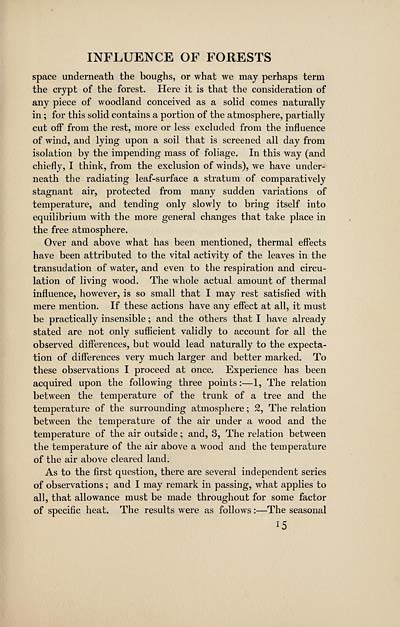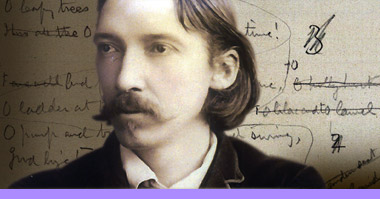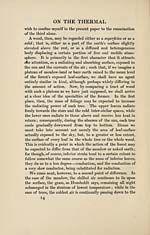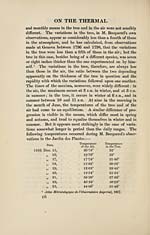Collected works > Edinburgh edition, 1894-98 - Works of Robert Louis Stevenson > Volume 28, 1898 - Appendix
(35) Page 15
Download files
Complete book:
Individual page:
Thumbnail gallery: Grid view | List view

INFLUENCE OF FORESTS
space underneath the boughs, or what we may perhaps term
the crypt of the forest. Here it is that the consideration of
any piece of woodland conceived as a solid comes naturally
in ; for this solid contains a portion of the atmosphere, partially
cut off from the rest, more or less excluded from the influence
of wind, and lying upon a soil that is screened all day from
isolation by the impending mass of foliage. In this way (and
chiefly, I think, from the exclusion of winds), we have under-
neath the radiating leaf-surface a stratum of comparatively
stagnant air, protected from many sudden variations of
temperature, and tending only slowly to bring itself into
equilibrium with the more general changes that take place in
the free atmosphere.
Over and above what has been mentioned, thermal effects
have been attributed to the vital activity of the leaves in the
transudation of water, and even to the respiration and circu-
lation of living wood. The whole actual amount of thermal
influence, however, is so small that I may rest satisfied with
mere mention. If these actions have any effect at all, it must
be practically insensible ; and the others that I have already
stated are not only sufficient validly to account for all the
observed differences, but would lead naturally to the expecta-
tion of differences very much larger and better marked. To
these observations I proceed at once. Experience has been
acquired upon the following three points : — 1, The relation
between the temperature of the trunk of a tree and the
temperature of the surrounding atmosphere ; 2, The relation
between the temperature of the air under a wood and the
temperature of the air outside ; and, 3, The relation between
the temperature of the air above a wood and the temperature
of the air above cleared land.
As to the first question, there are several independent series
of observations ; and I may remark in passing, what applies to
all, that allowance must be made throughout for some factor
of specific heat. The results were as follows : — The seasonal
15
space underneath the boughs, or what we may perhaps term
the crypt of the forest. Here it is that the consideration of
any piece of woodland conceived as a solid comes naturally
in ; for this solid contains a portion of the atmosphere, partially
cut off from the rest, more or less excluded from the influence
of wind, and lying upon a soil that is screened all day from
isolation by the impending mass of foliage. In this way (and
chiefly, I think, from the exclusion of winds), we have under-
neath the radiating leaf-surface a stratum of comparatively
stagnant air, protected from many sudden variations of
temperature, and tending only slowly to bring itself into
equilibrium with the more general changes that take place in
the free atmosphere.
Over and above what has been mentioned, thermal effects
have been attributed to the vital activity of the leaves in the
transudation of water, and even to the respiration and circu-
lation of living wood. The whole actual amount of thermal
influence, however, is so small that I may rest satisfied with
mere mention. If these actions have any effect at all, it must
be practically insensible ; and the others that I have already
stated are not only sufficient validly to account for all the
observed differences, but would lead naturally to the expecta-
tion of differences very much larger and better marked. To
these observations I proceed at once. Experience has been
acquired upon the following three points : — 1, The relation
between the temperature of the trunk of a tree and the
temperature of the surrounding atmosphere ; 2, The relation
between the temperature of the air under a wood and the
temperature of the air outside ; and, 3, The relation between
the temperature of the air above a wood and the temperature
of the air above cleared land.
As to the first question, there are several independent series
of observations ; and I may remark in passing, what applies to
all, that allowance must be made throughout for some factor
of specific heat. The results were as follows : — The seasonal
15
Set display mode to: Large image | Transcription
Images and transcriptions on this page, including medium image downloads, may be used under the Creative Commons Attribution 4.0 International Licence unless otherwise stated. ![]()
| Early editions of Robert Louis Stevenson > Collected works > Works of Robert Louis Stevenson > Appendix > (35) Page 15 |
|---|
| Permanent URL | https://digital.nls.uk/99383732 |
|---|
| Form / genre: |
Written and printed matter > Books |
|---|---|
| Dates / events: |
1898 [Date published] |
| Places: |
Europe >
United Kingdom >
Scotland >
Edinburgh >
Edinburgh
(inhabited place) [Place printed] |
| Subject / content: |
Essays Anthologies |
| Person / organisation: |
Colvin, Sidney, 1845-1927 [Author of introduction, etc.] |
| Form / genre: |
Written and printed matter > Books |
|---|---|
| Dates / events: |
1894-1898 [Date printed] |
| Places: |
Europe >
United Kingdom >
Scotland >
Edinburgh >
Edinburgh
(inhabited place) [Place printed] |
| Subject / content: |
Collected works |
| Person / organisation: |
Chatto & Windus (Firm) [Distributor] Stevenson, Robert Louis, 1850-1894 [Author] T. and A. Constable [Printer] Longmans, Green, and Co. [Publisher] Colvin, Sidney, 1845-1927 [Editor] |
| Person / organisation: |
Stevenson, Robert Louis, 1850-1894 [Author] |
|---|



